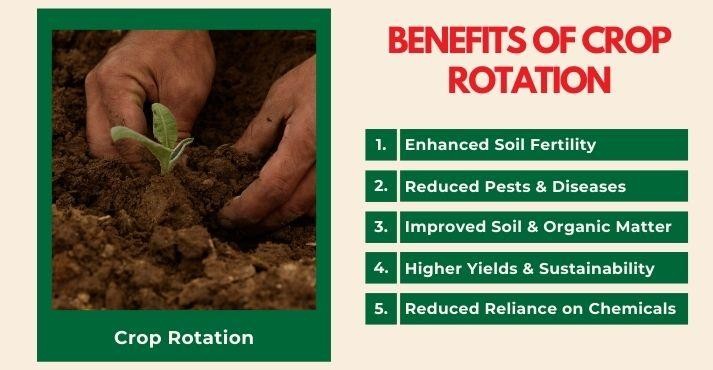Imagine walking through fields rich with vibrant crops, each one thriving without the heavy use of chemicals or fertilizers. This is the promise of sustainable farming, a method that not only protects our earth but also secures our food future.
One of the secrets to this success is crop rotation. If you’ve ever wondered how you can contribute to a healthier planet and ensure better produce, you’re in the right place. Crop rotation is more than just a farming technique; it’s a powerful tool that can transform the way we grow our food.
We’ll uncover the incredible role of crop rotation in sustainable farming and how it can benefit your environment and health. Stay with us to discover how a simple change can make a big impact.

Benefits Of Crop Rotation
Crop rotation boosts soil health by alternating crops, reducing pests naturally, and increasing yield. It minimizes chemical use, promoting eco-friendly farming. Sustainable practices like these ensure long-term farm productivity.
Crop rotation is a time-tested farming practice that plays a crucial role in sustainable agriculture. By switching different crops in the same area across seasons, farmers can harness numerous benefits that support both the environment and their yields. Let’s explore why crop rotation is a cornerstone of sustainable farming and how it can benefit you directly.1. Improved Soil Health
Switching crops can significantly enhance soil quality. Different plants have varying nutrient needs and root structures. Planting them in rotation prevents depletion of specific nutrients and improves soil structure, allowing better water retention and aeration.2. Pest And Disease Control
Crop rotation disrupts the life cycles of pests and diseases. Pests often thrive when the same crop is planted repeatedly. By changing crops, you can naturally reduce pest populations without relying heavily on chemical pesticides.3. Enhanced Crop Yields
The practice can lead to higher yields over time. Nutrient-rich soil and reduced pest pressure mean that crops have the best chance to grow strong and healthy. You might notice an increase in productivity, making your farm more profitable.4. Reduced Soil Erosion
Different crops provide various levels of ground cover. This diversity helps protect the soil from erosion caused by wind and water. Keeping your soil intact ensures that future crops have a stable foundation to grow.5. Increased Biodiversity
Rotating crops promotes a variety of plant species, which in turn supports a broader range of wildlife. This biodiversity can create a more balanced ecosystem on your farm, potentially attracting beneficial insects that help with pollination and pest control.6. Nutrient Cycling
Different plants contribute and take different nutrients from the soil. For instance, legumes can fix nitrogen, replenishing this crucial nutrient for future crops. By rotating, you ensure that the soil remains fertile and balanced.7. Weed Suppression
Crop rotation can help manage weed populations. Some crops naturally suppress weeds by shading them out or through allelopathy, a process where plants release chemicals that inhibit weed growth. This means less time spent on weed management and more time enjoying a healthier farm. Have you ever tried crop rotation on your farm or garden? If not, consider giving it a shot to experience these benefits firsthand. What other methods have you found effective for sustainable farming? Engage with these ideas and try implementing them in your own practices.
Soil Health Improvement
Crop rotation plays a key role in sustainable farming practices. It greatly enhances soil health, making it vital for productive agriculture. The method involves alternating different crops on the same land over seasons. This simple technique brings multiple benefits to the soil.
Improved Nutrient Balance
Different crops use various nutrients from the soil. Rotating crops helps maintain a balanced nutrient level. Legumes, for instance, add nitrogen to the soil. This reduces the need for chemical fertilizers. Healthy soil promotes better crop yields.
Reduced Soil Erosion
Crop rotation helps prevent soil erosion. Certain crops have deep roots that hold soil together. These roots improve soil structure and stability. Erosion is minimized, preserving topsoil quality.
Enhanced Organic Matter
Organic matter is crucial for soil health. Rotating crops increases organic matter content. This enriches the soil and boosts microbial activity. Microbes play a key role in nutrient cycling. Active soil life supports robust plant growth.
Better Pest And Disease Control
Crop rotation disrupts pest and disease cycles. Pests often target specific crops. Rotating crops confuses them, reducing infestations. Fewer pests mean healthier plants. Disease spread is minimized, reducing crop losses.
Improved Soil Structure
Different crops have varied root systems. These roots improve soil structure. Good soil structure allows better water infiltration. Water retention is enhanced, supporting plant hydration. Proper soil structure ensures plant stability.
Pest And Disease Management
Crop rotation plays a vital role in sustainable farming. It helps manage pests and diseases effectively. By alternating crops, farmers disrupt pest and disease life cycles. This natural method reduces the need for chemical pesticides. Let’s explore how crop rotation assists in pest and disease management.
Understanding Pest Cycles
Pests thrive when the same crop grows repeatedly. They adapt and become harder to control. Rotating crops confuses pests. Each crop has different pests and diseases. This disrupts the pest’s life cycle. Reduced pest numbers mean less damage to crops.
Disease Suppression
Certain crops are prone to specific diseases. These diseases linger in the soil. Crop rotation prevents this buildup. Different crops reduce disease spores in the soil. This natural disease suppression keeps plants healthier.
Improving Soil Health
Healthy soil supports disease management. Crop rotation improves soil structure. Different crops add varied nutrients back into the soil. This diverse nutrient profile strengthens plant immunity. Strong plants resist pests and diseases better.
Enhanced Biodiversity
Rotating crops increases farm biodiversity. Diverse plants attract different beneficial insects. These insects act as natural predators. They help control pest populations. Biodiversity creates a balanced ecosystem, minimizing pest outbreaks.

Economic Impacts
Crop rotation offers significant economic benefits for farmers. It enhances soil health, leading to more productive crops. This practice reduces the need for expensive chemical inputs. Farmers can cut costs and increase profits. Crop rotation also increases biodiversity, which helps control pests naturally. This minimizes the reliance on costly pesticides.
Reducing Chemical Costs
Crop rotation minimizes the need for fertilizers and pesticides. Healthy soil supports stronger plants, reducing chemical dependency. Farmers save money on fertilizers and pesticides. These savings contribute directly to farm profitability.
Boosting Crop Yield
Rotating crops can lead to higher yields. Healthy soil produces stronger plants. This results in more abundant harvests. Higher yields mean more products to sell. This increases income for farmers.
Increasing Market Opportunities
Diverse crops offer varied market opportunities. Farmers can grow multiple types of crops. This diversification opens up new sales channels. It enhances market presence and stability.
Reducing Risk
Crop rotation helps manage farming risks. It reduces the chance of crop failure. Healthy soil supports better crop growth. This leads to more reliable and consistent harvests.
Conclusion
Crop rotation helps maintain healthy soil. It reduces pests and diseases naturally. Farmers can improve yields and reduce chemical use. This practice supports biodiversity and preserves resources. It’s an essential tool for sustainable farming. A diverse crop system benefits the environment.
It also ensures long-term agricultural success. Farmers who rotate crops promote ecological balance. This method is both practical and effective. Healthy soil leads to healthy crops. Crop rotation is a simple yet vital strategy. Sustainable farming depends on such practices.
By rotating crops, farmers nurture the earth. This benefits future generations too.

